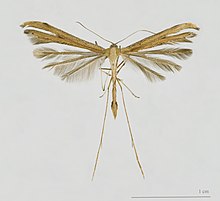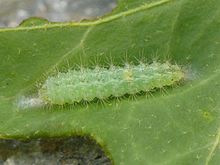|
Emmelina monodactyla
Emmelina monodactyla (also known as the T-moth or morning-glory plume moth) is a moth of the family Pterophoridae found in Africa, Asia, Europe and North America. It was first described by Carl Linnaeus in 1758. DescriptionThe moths fly nearly year-round.[1] They are pale russet in colour, with a wingspan of 18–27 millimeters. The colouration is extremely variable, ranging from off-white with indistinct markings to a strong rust brown. The markings may vary considerably in size. The second and third segments are elongate. The caterpillars are greenish-yellow with a broad green band on the back, and a narrow broken yellow line running down the center. Some specimens may also have a wine-red marking on the back. The colour of the pupae may range from green to reddish brown, sometimes with black markings.[2][3]
BiologyThe larvae feed from May to September in two overlapping generations.[1] They mainly feed on Convolvulaceae species, including hedge bindweed (Calystegia sepium), low false bindweed (Calystegia spithamaea]], sea bindweed (Calystegia soldanella), field bindweed (Convolvulus arvensis), Cantabrican morning glory (Convolvulus cantabrica), Convolvulus floridus, Convolvulus prostratus, dwarf morning-glory (Convolvulus tricolor), sweet potato (Ipomoea batatas), Ipomoea eriocarpa and common morning-glory (Ipomoea purpurea). They also feed on Atriplex species, including common orache (Atriplex patula) and Chenopodium, including fat-hen (Chenopodium album) from the family Amaranthaceae, cardoon (Cynara cardunculus) from the family Asteraceae, and thorn apple (Datura stramonium) and henbane (Hyoscyamus niger) from the family Solanaceae.[4]
DistributionIt is found in Europe, central Asia, Japan, North Africa and North America. References
External links
|
||||||||||||||||||||||||||||||||
Portal di Ensiklopedia Dunia





